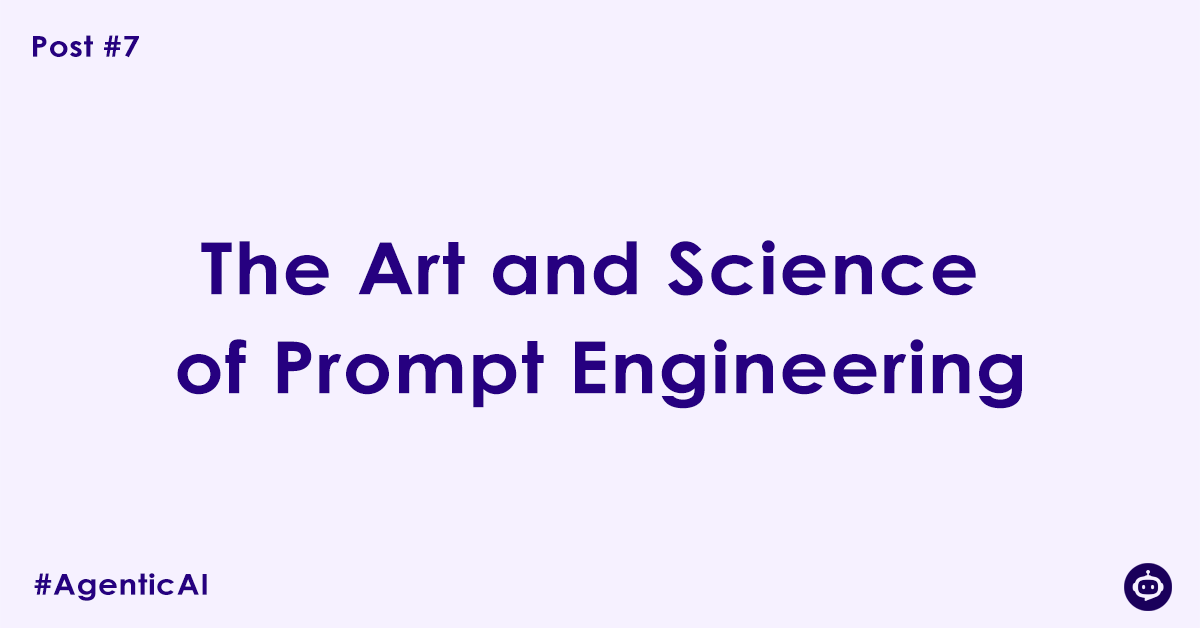We’ve explored the architecture of an AI agent, from its LLM brain to its memory and tools. But there’s a critical component that dictates its success or failure: the instruction it receives. An agent, for all its power, is a brilliantly capable but extremely literal assistant. It will do exactly what you say, not necessarily what you mean.
This is where Prompt Engineering comes in. It is the crucial skill of carefully crafting instructions to guide an AI agent toward a desired, predictable, and useful outcome. It’s less about writing code and more about mastering the art of clear communication with a non-human intelligence.
A great prompt is both an art and a science. The “science” lies in understanding the principles of effective instruction, while the “art” is in the creative use of language to achieve nuanced results. Let’s dive into the core principles every agent architect should know.
Principle 1: Be Specific and Explicit
Vagueness is the enemy of predictability. The AI agent does not share your implicit context, background knowledge, or unstated assumptions. You must provide all the necessary details for it to succeed.
- Bad Prompt: “Write a summary of our meeting.”
- Why it’s bad: How long should the summary be? What format? Who is the audience? What were the key topics? The agent is forced to guess, leading to generic results.
- Good Prompt:
Act as a project manager.
Review the following meeting transcript and write a summary for the executive team.
The summary should be a single paragraph, no more than 150 words.
Focus on the three key decisions made and the action items assigned to each person.Principle 2: Provide Context and Persona
Telling an agent who it should be is one of the most powerful ways to shape its response. A persona provides a lens through which the agent interprets the request and formulates its output, influencing everything from tone and vocabulary to the level of detail.
- Bad Prompt: “Explain how a vector database works.”
- Why it’s bad: The explanation could be highly technical and academic, or overly simplistic. The output is a gamble.
- Good Prompt:
You are a senior AI engineer explaining a complex topic to a new marketing manager.
Explain how a vector database works using a simple analogy, like a library for ideas.
Keep the tone friendly, encouraging, and avoid technical jargon.Principle 3: Use Clear Structure and Formatting
A long, unstructured prompt can be as confusing for an AI as it is for a human. Use formatting to create a clear separation between instructions, context, examples, and input data. Delimiters (like ###, ---, or XML tags) are excellent for this.
- Bad Prompt: “Here is a customer review ‘The app is great but it keeps crashing on startup’. I need you to classify its sentiment and extract the specific technical issue mentioned.”
- Why it’s bad: The instruction and the data are mixed together, which can sometimes confuse the model, especially with more complex inputs.
- Good Prompt:
### INSTRUCTION ###
Analyze the following customer review. Your task is to perform two actions:
1. Classify the sentiment as either Positive, Negative, or Mixed.
2. Extract the specific technical problem being reported. If no technical problem is mentioned, write "N/A".
### CUSTOMER REVIEW ###
"The app is great but it keeps crashing on startup"Principle 4: Show, Don’t Just Tell (Few-Shot Prompting)
Sometimes, the best way to explain what you want is to show an example. Providing one or more complete examples of the task within your prompt is a technique called “few-shot prompting.” This helps the model understand the desired output format and reasoning pattern.
- Bad Prompt: “Turn the product description into marketing copy.”
- Why it’s bad: “Marketing copy” is subjective. The model’s interpretation might not align with your brand’s voice.
- Good Prompt:
Turn the technical product description into engaging marketing copy, following the example below.
---
EXAMPLE 1
Description: "Our new SSD has a 2TB capacity and uses a PCIe 4.0 interface for faster data transfer."
Marketing Copy: "Unleash breathtaking speed and store everything that matters! Our new 2TB SSD leverages cutting-edge PCIe 4.0 technology to slash loading times and supercharge your workflow."
---
EXAMPLE 2
Description: "The XT-500 camera features a 24MP sensor and 4K video recording capabilities."
Marketing Copy:Principle 5: Guide the Reasoning Process (Chain-of-Thought)
For complex tasks that require multiple steps of reasoning, you can dramatically improve accuracy by asking the agent to “think step-by-step.” This technique, often called Chain-of-Thought (CoT) prompting, forces the model to articulate its reasoning process before giving a final answer, reducing logical errors.
- Bad Prompt: “A t-shirt costs $25, but it’s on sale for 20% off. If sales tax is 5%, what is the final price?”
- Why it’s bad: The model might try to compute this in one go and make a simple arithmetic error.
- Good Prompt:
A t-shirt costs $25, but it's on sale for 20% off. Sales tax is 5%. Calculate the final price.
Think step-by-step:
1. First, calculate the discount amount.
2. Second, subtract the discount from the original price to find the sale price.
3. Third, calculate the sales tax on the sale price.
4. Finally, add the sales tax to the sale price to get the final cost.Conclusion: The Human in the Loop
Prompt engineering is the bridge between human intent and machine execution. It’s an iterative process of crafting, testing, and refining your instructions. By mastering these fundamental principles, you transform your interaction with an AI agent from a game of chance into a predictable and powerful collaboration. The quality of your prompts directly determines the quality of your results, making it one of the most essential skills in the new age of artificial intelligence.
Author

Experienced Cloud & DevOps Engineer with hands-on experience in AWS, GCP, Terraform, Ansible, ELK, Docker, Git, GitLab, Python, PowerShell, Shell, and theoretical knowledge on Azure, Kubernetes & Jenkins. In my free time, I write blogs on ckdbtech.com
